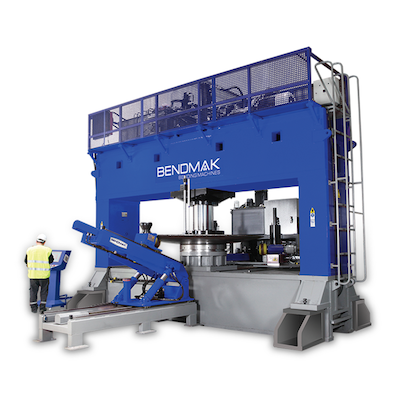
Posted By: Bendmak | Posted On: Jun 15, 2021 12:00:00 AM
How to Find the Right Angle Roller to Improve Accuracy and Productivity
The Angle Rolling process is a critical component of metal fabricating and especially that of structural steel fabrication. Angle rolls (sometimes called Profile Rolls) can form just about any ductile material from flats to rounds and shapes with varying degrees of radii. In this article we will introduce the reader to what angle rolls are, provide some common applications where they are used and guide you to selecting the right angle roll for your application.
What Is Angle Rolling?
Angle rolling is the process of using an angle roll machine to shape, twist, bend or coil a material between its powerful rollers. It is a process used on shaped materials that are flat, angled, round or square and tubing shapes as well.
What Are Angle Roller Machines?
An angle roll is the machine utilized in the angle rolling process. This machine forms long flat shapes into round, semi-round or varying radii. These materials are typically Angles, Solids, Flats, Squares or Tubing but can be just about any shape you can fit between the rolls themselves. They simply take a flat shape of metal and make it into various rounded shapes.
Common Applications of Angle Rollers
Angle Rolls are used to manufacture a variety of goods and are heavily used in structural and other heavy fabrication construction. Good examples of industries that use ANgle Roll machines are:
- Structural Fabrication (High Rise and Steel Buildings)
- Electrical Transmission
- Shipbuilding
- Grain Silos
- Water Towers
- Wind Towers
- Pressure Vessels
- Aviation and Spacecraft manufacturing
- Truck and Trailer Bodies
- Defense Industry
- Pipelines
How Do Angle Rollers Work?
The basics of an angle rol operation is fairly simple. The process consists of taking the flat edge of the part, feeding into the machine and using the pinching action of two of the rollers the third roller is brought up to begin the bending process. These 3 rollers are then driven simultaneously forward and backward bending the metal to the shape desired in a series of “passes”. Depending on the yield strength of the material and the desired final shape the number of “passes” will vary. The benefit of using this method to form parts is that there is a smooth radius created and smooth transition of radius’s from parts with varying radii.
Metals Used in Angle Rollers
Angle rolls can form a wide variety of materials and shapes. Metals like Steel, Aluminum, Stainless are common but also they can form iron, brass, copper and many other materials that are ductile enough to yield under force without fracturing.
Different Roll Styles
Angle rolls come in 3-Roll single-pinch designs, and 3-Roll Double-pinch varieties. In the single pinch design the lower rolls are power driven but do not move towards each other or the top roll to pinch the workpiece. In the double pinch design the bottom rolls both move towards the top roll allowing for ease in pre-bending materials in one setup making the double pinch design far more popular.
How to Find the Right Angle Roll Machine
Choosing an Angle Roll machine may seem difficult but it really breaks down into a few simple steps. First determine the maximum size and type of material you will be rolling. Next determine the types of profiles (angles, flats, tubes etc.) that you will be forming. Lastly determine if you will be rolling material into one simple radius or if you will have or need the ability to have, capability of forming variable radii.
The answers to these questions will tell you the following:
- Size: What model machine do I need?
- Profile Types: What Set of Rolls can I use and do I need additional work holding on the machine to keep my profile from twisting or coiling such as stretching or pulling devices?
- Variable Radii: Whether or not a CNC Controller is required.
By answering some of these basic questions you can easily select the model machine that will work best for you. You may have to consult with your sales engineer to discuss the other applications and determine which other options may be necessary to make your rolling a success.
Find the Best New & Used Angle Rollers At BendmakUSA
Finding the right manufacturer of the Angle Roll for your application is only the start. You then need to choose the right model and options to equip your machine with. Do you need a Pulling Device to add support to forming material that may twist? How about a Stretching Device to keep the material in the right geometry from coiling? Do you need custom rolls that are shaped or a special profile or to prevent scratching? How about a CNC control to provide automation and control of all these actions running together or producing parts with variable geometries?
At BendmakUSA we can help you make the right selection from Bendmak's wide range of Angle/Profile Bending Rolls. Contact your local Bendmak sales representative or connect with us direct to help guide you in the right direction of selecting the right machine, equipped the right way for your application.


